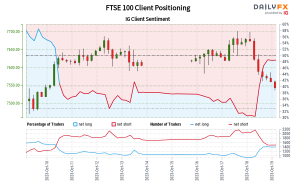Number of traders net-short has decreased by 23.06% from last week.
| SYMBOL | TRADING BIAS | NET-LONG% | NET-SHORT% | CHANGE IN LONGS | CHANGE IN SHORTS | CHANGE IN OI |
|---|---|---|---|---|---|---|
| FTSE 100 | BEARISH | 50.60% | 49.40% | 55.95% Daily 31.67% Weekly | -33.41% Daily -23.06% Weekly | -6.22% Daily -2.56% Weekly |
| Change in | Longs | Shorts | OI |
| Daily | 56% | -33% | -6% |
| Weekly | 32% | -23% | -3% |
FTSE 100: Retail trader data shows 50.60% of traders are net-long with the ratio of traders long to short at 1.02 to 1. In fact, traders have remained net-long since Oct 10 when FTSE 100 traded near 7,617.50, price has moved 1.54% lower since then. The number of traders net-long is 55.95% higher than yesterday and 31.67% higher from last week, while the number of traders net-short is 33.41% lower than yesterday and 23.06% lower from last week.
We typically take a contrarian view to crowd sentiment, and the fact traders are net-long suggests FTSE 100 prices may continue to fall.
Our data shows traders are now net-long FTSE 100 for the first time since Oct 10, 2023 08:00 GMT when FTSE 100 traded near 7,617.50. Traders are further net-long than yesterday and last week, and the combination of current sentiment and recent changes gives us a stronger FTSE 100-bearish contrarian trading bias.




 آموزش مجازی مدیریت عالی و حرفه ای کسب و کار DBA
آموزش مجازی مدیریت عالی و حرفه ای کسب و کار DBA









ارسال نظر شما
مجموع نظرات : 0 در انتظار بررسی : 0 انتشار یافته : ۰